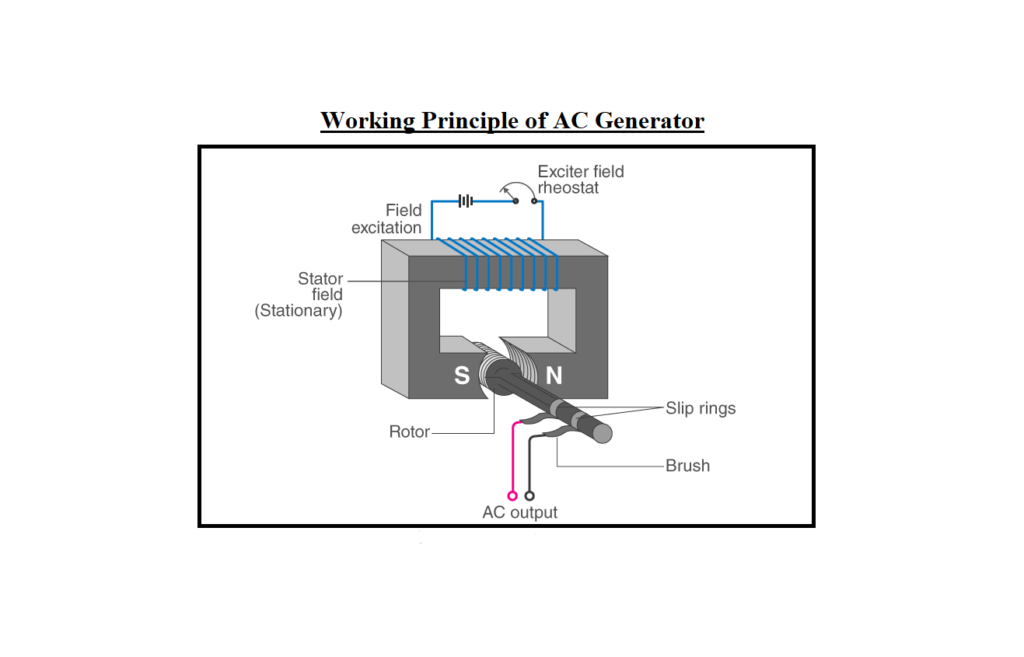Working Principle of AC Generator – An alternating current generator (AC generator) is a device that converts mechanical energy into alternating electrical energy for use. AC generators employ slip rings to produce alternating current, whereas DC generators use direct current. Power plants, sailboats, electric scooters, bicycles, and other applications all employ AC generators. Mechanical energy is typically supplied to AC generators by steam and gas turbines, as well as internal combustion engines. AC generators are useful in wind turbines, small hydropower plants, and in converting high-pressure gas streams to lower-pressure gas streams.
The Linquip platform offers you all the information you need about AC generator equipment, devices, and related products that are available in the market today. It would be our pleasure to assist you with any questions you may have about AC generators. For more information, please contact our expert team today. It would be wise for you to take a few moments to read Linquip’s article entitled, “What is Generator?“.
If you register as a Linquip Expert, you will have complete access to every conceivable feature of Linquip. If you wish to contribute to Linquip as a Guest Poster, then why not? Linquip accepts Guest Posts, so that is an option that is available to you.
What is an AC Generator?
A machine that turns mechanical energy into electrical energy in the form of alternate EMF is known as an AC generator. Faraday’s Law of Electromagnetic Induction governs the operation of a simple AC generator. It’s made out of a wire coil that spins in a magnetic field.
Working Principle of AC Generator
The Working Principle of AC Generators is that they are frequently referred to as alternators and operate on the principle of Faraday’s Law of Electromagnetic Induction. The magnetic flux associated with the coil changes when a conductor moves in a uniform magnetic field, causing an EMF.
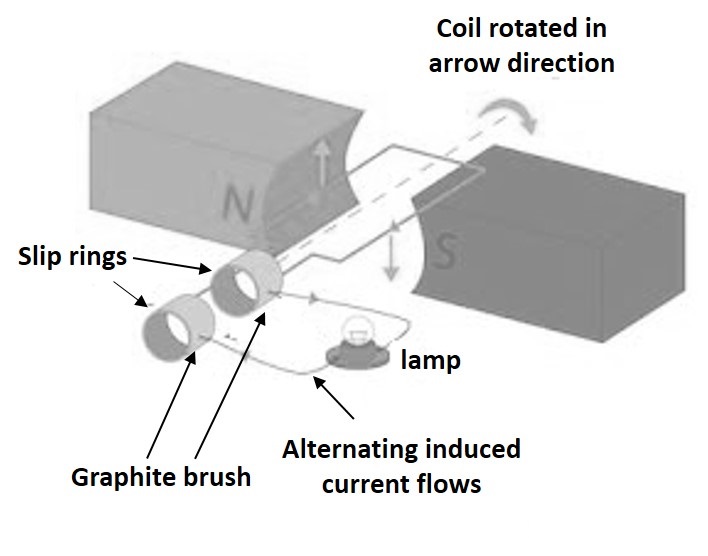
Electricity is widespread, from flipping a switch to heating a snack in the microwave. You might be wondering how this vital energy source is generated and delivered to your home now that you’ve given it some attention.
Turbines and generators are used to generate electricity in power plants. Electric generators convert rotation into electricity, while turbines transform available energy into rotation. Generators are divided into two groups based on their electric output: AC Generators and DC Generators. The functioning principle and components of an AC generator will be discussed in-depth in this post. If you want to learn more about the working principle and characteristics of a DC generator, visit our post-DC Generator.
A machine that converts mechanical energy into electrical energy is known as an AC generator. Mechanical energy is supplied to the AC Generator through steam turbines, gas turbines, and combustion engines. Alternating electrical power in the form of alternating voltage and current is the output.
Faraday’s law of electromagnetic induction states that electromotive force (EMF or voltage) is generated in a current-carrying conductor that cuts a uniform magnetic field. AC generators work on this basis. Rotating a conducting coil in a static magnetic field or rotating the magnetic field enclosing the stationary conductor can both be used to accomplish this. Because it is easier to extract induced alternating current from a stationary armature coil than from a revolving coil, this is the favored configuration.
The coil, slip rings, brushes, and a strong magnetic field are the main components of the AC generator.
The Function of AC Generator in Details
To create a strong magnetic field, the coil is rotated in the magnetic field. An EMF is induced in one direction as a coil goes up through the magnetic field on one side. An EMF is induced in the reverse direction as the coil rotates and this side of the coil moves down and another side of the coil moves up. The direction of the induced EMF is determined using Fleming’s right-hand rule. Every cycle, this process is repeated, and the EMF generated is of the alternating type.
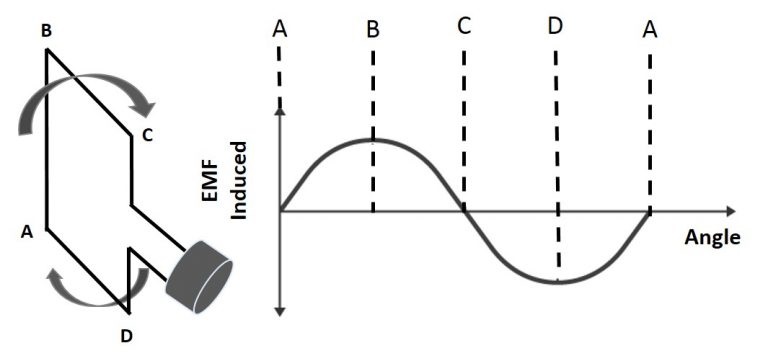
A graph depicting the output of an AC generator is displayed above. The description of the letters is as follows:
- A – When the coil is at 0 degrees, it moves parallel to the magnetic field’s direction and so produces no EMF.
- B – The coil moves at 90 degrees to the magnetic field and hence induces the most EMF when it is at 90 degrees.
- C – When the coil is rotated 180 degrees, it moves parallel to the magnetic field again, causing no EMF to be generated.
- D – When the coil is at 270 degrees, it goes back to 90 degrees to the magnetic field, inducing the maximum EMF. The induced EMF in this case is the polar opposite of B’s.
- A – The coil has completed one rotation when it reaches 360 degrees when it moves parallel to the magnetic field and produces zero EMF.
Consider a rectangular coil with ‘N’ turns rotating in a homogeneous magnetic field ‘B’ with an angular velocity of ‘’. At every time ‘t’, the angle between the magnetic field ‘B’ and the normal to the coil is given by, θ = ωt.
The magnetic flux is perpendicular to the plane of a coil in this location, and it is given by B Cos ωt. The magnetic flux associated with a coil of N turns is equal to ɸ = B Cos ωt A, where A is the coil’s area. Faraday’s Laws of Electromagnetic Induction determine the induced EMF in the coil.
\varepsilon =-\frac{d\phi }{dt}=-\frac{d(NBAcos\omega t)}{dt}=NBA\omega sin(\omega t)
When the coil rotates through 90 degrees, the value of sine approaches 1 and the induced EMF reaches its maximum, reducing the preceding equation to:
{\varepsilon}_{0} =N{B}_{m}A\omega=N{B}_{m}A2\pi f
Where
The maximal flux density in Wb/m2 is denoted by Bm,
The area of a coil in m2 is denoted by the letter ‘A’,
And ‘f’ stands for the frequency of a coil’s rotation in revolutions per second.
By Substituting the second equation in the first one,
{\varepsilon}={\varepsilon}_{0}sin(\omega t)
The term “induced alternating current” refers to the current that is generated when a device is turned on.
I=\frac{\varepsilon }{R}=\frac{{\varepsilon }_{0}sin\omega t}{R}
The flux linkage of the armature varies continually as it revolves between the poles of the magnet on an axis perpendicular to the magnetic field. An electric current travels through the galvanometer, slip rings, and brushes as a result. The galvanometer changes its value from positive to negative. This implies that the galvanometer is receiving an alternating current. Fleming’s Right-Hand Rule can be used to determine the direction of the induced current.
Construction of AC Generator Principle
The Rotor and Stator are the two major components of a simple AC generator. A rotor is a revolving component, whereas a stator is a machine’s fixed component.
Stator
The stator is a stationary component that holds the armature coil in place. The objective of the armature winding is to carry current to the load, which might be any external equipment that uses electricity. It is divided into three sections:
- Stator Frame – It’s an exterior frame that holds both the stator core and the armature windings.
- Stator Core – To reduce eddy current losses, it is laminated with steel or iron. To hold armature windings, slots are cut into the interior of a core.
- Armature Windings – Armature windings are wound on armature core slots.
Rotor
An AC generator’s rotor is a rotating component. Magnetic field windings make up the structure. Magnetic poles are magnetized using a DC source. Slip rings are attached to each end of the magnetic field windings. The rotor rotates on a common shaft, which is coupled to this combination. Salient pole rotors and cylindrical pole rotors are the two types of rotors.
Salient Pole Rotor
The most important pole rotor type is depicted in the diagram below. The number of poles protruding, known as salient poles, with their bases fixed to the rotor, may be seen in this sort of rotor. They’re used in applications with low and medium speeds.
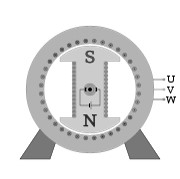
Cylindrical Pole Rotor
Cylindrical rotors have an unruffled and sturdy cylinder with slots positioned on the cylinder’s outside surface. It’s employed in applications that require a lot of speed. The cylindrical pole rotor is seen in the diagram below.
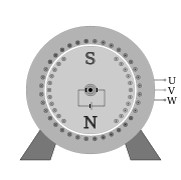
Types of AC Generator Principle
AC generators are classified into two types based on their working principle.
Asynchronous Generators
Induction generators are another name for asynchronous generators. Slip aids the rotor’s rotation in this type of generator. The rotor tries but fails to match the stator’s synchronous speed. When the rotor equals the stator’s synchronous speed, the relative velocity is zero, and the rotor has no torque. They can be used to power wind turbines.
Synchronous Generators
A synchronous generator is an AC generator that rotates at the same speed all the time. It works based on Faraday’s law of electromagnetic induction, which states that when a coil rotates in a uniform magnetic field, an EMF is induced. They are mostly utilized to create high voltages in power plants.
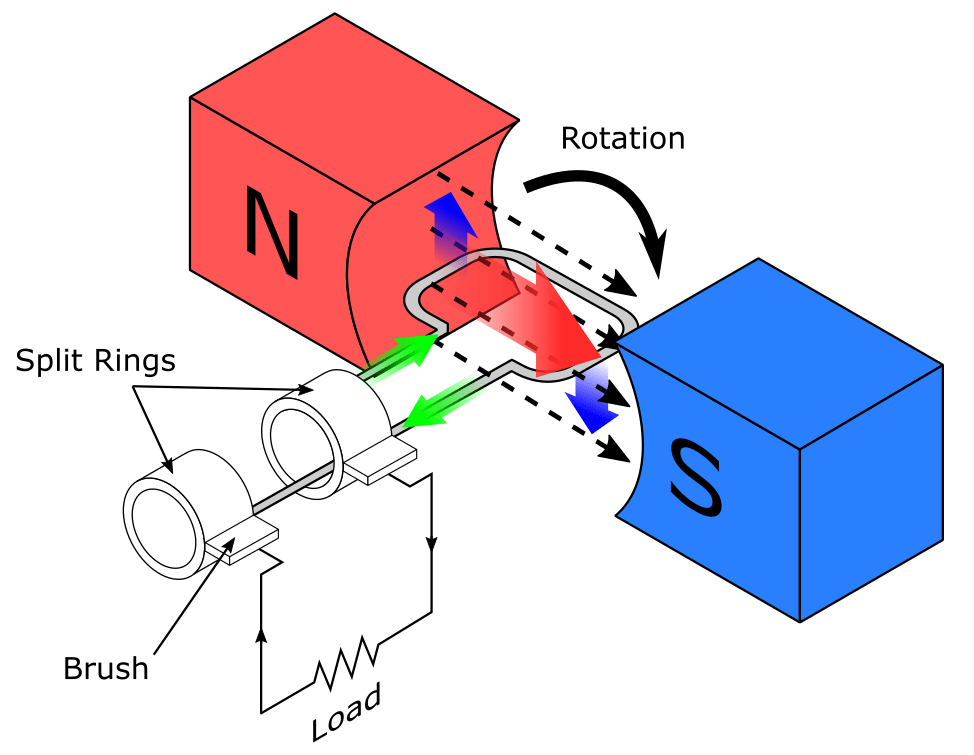
Applications
The AC generator is used to generate electricity from windmills, hydroelectric dams, and other sources.
Advantages of AC Generators over DC Generators
AC generators have the following advantages over DC generators:
- Through transformers, AC generators can be simply stepped up and down.
- Because of the step-up feature, the transmission link size in AC Generators is less.
- The losses in AC generators are lower than those in DC machines.
- An AC generator is smaller in size than a DC generator.
The majority of us begin our studies with direct current, but we soon discover that it is not the only sort of current we encounter. Voltages and currents that are alternating in nature are produced by some power sources. Alternating current, or AC, is the name for this type of electricity. The video will assist you in understanding the Working Principle of the AC Generator.
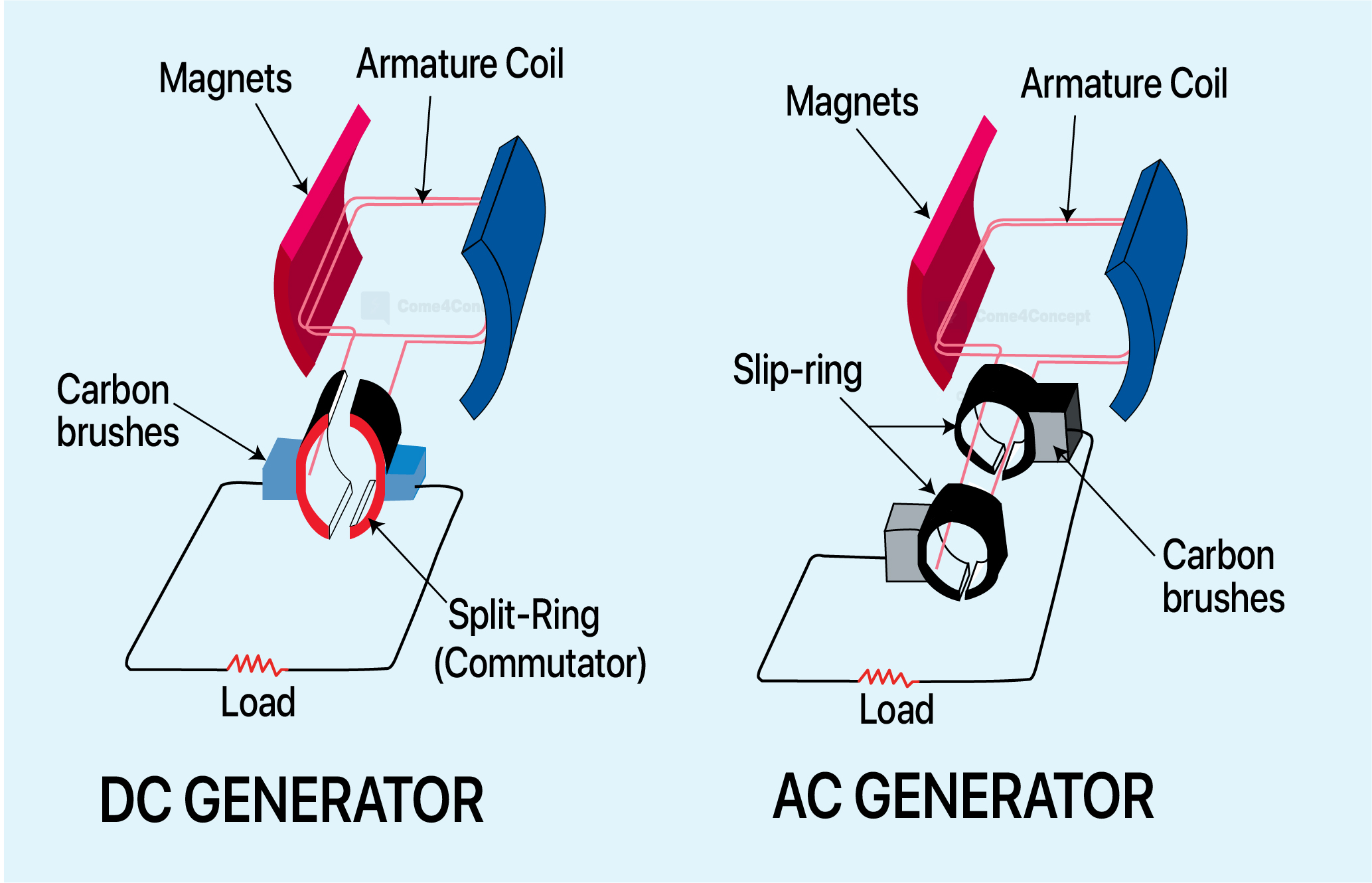
FAQs about the Working Principle of AC Generator
1) What Is the Difference Between the AC Generator and the DC Generator?
The electrical current in an AC generator alternates its direction regularly, resulting in alternating current. The electrical current in a DC generator flows in only one direction.
2) Do Car Alternators Have AC or DC?
The rotating armature generates the AC, which is converted to DC using a commutator and brushes.
3) AC Generator Works on Which Principle?
It operates according to Faraday’s Laws of Electromagnetic Induction.
4) What Are the Types of AC Generators?
Synchronous and Asynchronous AC generators.
5) Are Batteries AC or DC?
Batteries are classified as DC because they only conduct current in one direction.
6) How Does an AC Generator Produce Electricity?
Faraday’s law of electromagnetic induction governs the operation of AC generators. The flux linkage of the armature varies continually as it revolves between the magnet’s poles on an axis perpendicular to the magnetic field. An EMF is created in the armature as a result of this. An electric current travels through the galvanometer, slip rings, and brushes as a result.
7) What Factors Do the Generated EMF In an Alternator Depend Upon?
The amount of EMF created is determined by the number of armature coil turns, magnetic field intensity, and rotational field speed.
8) What Are Some Advantages of AC Generators Over DC Generators?
Through transformers, AC generators can be simply stepped up and down. The losses in AC generators are lower than those in DC machines.
9) In which part of the AC generator is the output generated?
The armature is where the output is generated.
The AC generator and its operation were explored in this post.
Download the Working Principle of AC Generator PDF
Our post includes a PDF document that you can save for future use as a reference, which you can use whenever you need it. By following the link below, you will be able to download the PDF file.
Buy Equipment or Ask for a Service
By using Linquip RFQ Service, you can expect to receive quotations from various suppliers across multiple industries and regions.
Click Here to Request a Quotation From Suppliers and Service Providers
Read More on Linquip
- Applications of AC Generators: 2022 Ultimate Guide
- What is Generator Efficiency? Calculation & Formula Guide
- What are the parts of AC Generators?
- A Clear Classification of AC Generators
- What Is a Generator? A Comprehensive Explanation of Working Principles, Types, and Components
- What is the Working Principle of a DC Generator?
- Parts of DC Generator: Explanation of Parts, Working, Types, Advantages & Disadvantages
- Working Principle of Diesel Generator + Diagram
- Electric Generator Maintenance, Repair, and Services (2022 Guide)
- Gasoline Generator Repair and Maintenance (2022 Guide)
- How Much Does It Cost to Install a 22kW Generac Generator?
- How Long Can A Standby Generator Run Continuously?
- What is the Difference Between a Whole House and Standby Generator?
- The Difference Between Prime & Standby Generators
- Can I install a Standby Generator Myself? (An All-In-One Guide)
- Portable vs. Standby Generator (Best Choose for Home in 2022)
- DC Generator Repair, Maintenance & Testing 2022 (Full Guide)
- Pros and Cons of Inverter Generators in 2022

